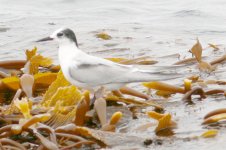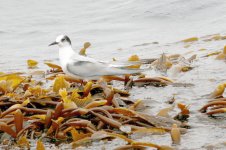I hate to disagree with someone like CAU... because he is usually right!
Also, I know that the pattern on the underside of the primaries can be deceptive in photographs, depending on the angle towards the camera, as rightly pointed out by CAU.
However, I would like to add the following to the discussion:
- Moult: I think there is still a lot we do not know about moult in Arctic Tern. All the books say that they conclude their primary moult in the winter quarters (i.e. Antarctica), but in the field, I have noticed that a few birds replace inner primaries during early summer. Here is an example:
http://waarnemingen.be/waarneming/view/55478216
- Tail: I think noone has mentioned it so far, but 1st-summer Common Tern normally has short outer tail streamers. In the subject bird, the tail streamers are long, and reach the end of the wingtip at rest, as they do in 1st-summer Arctic.
- Secondaries: 1st-summer Common Tern has distinctly dark secondaries, often visible on the underwing too as a dark bar. If you look at the white tips on the secondaries of the subject bird (particularly in
this photograph), they become wider inward, towards the body - a feature of Arctic Tern.
- Underwing: It is not just the narrow dark tips to the primaries that attract my attention, but also (and perhaps even more so) the contrast between these (black) tips and very pale (white) underwing.
- Structure: Nobody has mentioned the short arm and very long hand in flight?
- Additional features: The distinct white scapular and tertial crescents may be worth noting. For some reason, these usually seem to be narrower and less distinct in 1st-summer Common Tern.
It is always good to have comparison material in discussions like this, and I think that Shaibal Mitra's collection of 1st-summer terns is one of the largest on the internet.
Common:
https://picasaweb.google.com/109808209543611018404/CommonTernsOnLongIsland#
Arctic:
https://picasaweb.google.com/109808209543611018404/ArcticTernsOnLongIsland#
Shaibal's photos of 1st-summer Arctic include a bird moulting its inner primaries, and another with prominent white eyering:
https://picasaweb.google.com/109808209543611018404/ArcticTernsOnLongIsland#5197640919303875010
Kevin Karlson also has a few shots of 1st-summer Arctic:
http://www.kevinkarlsonphotography.com/gallery/v/Gulls/terns/





